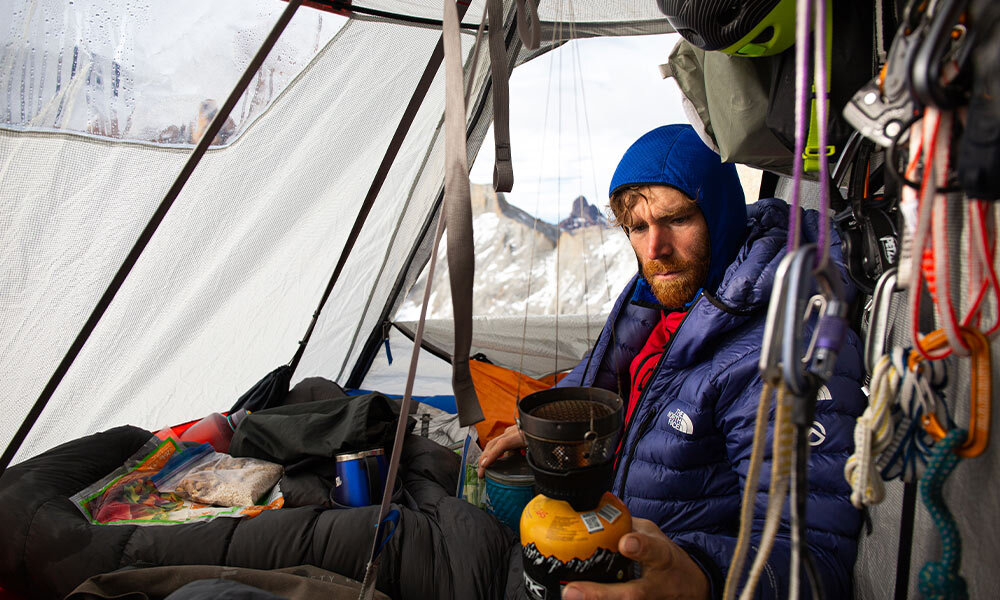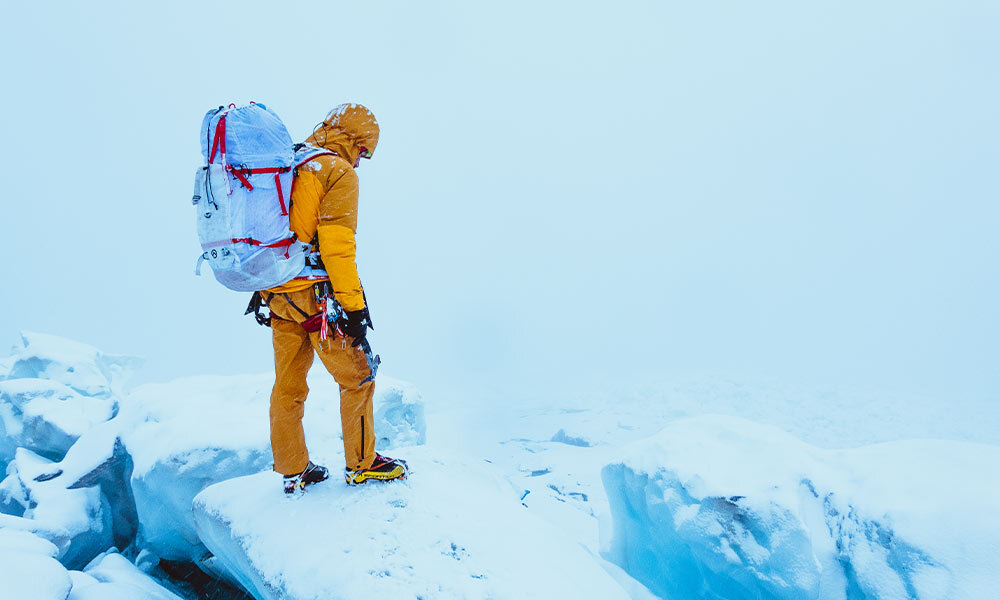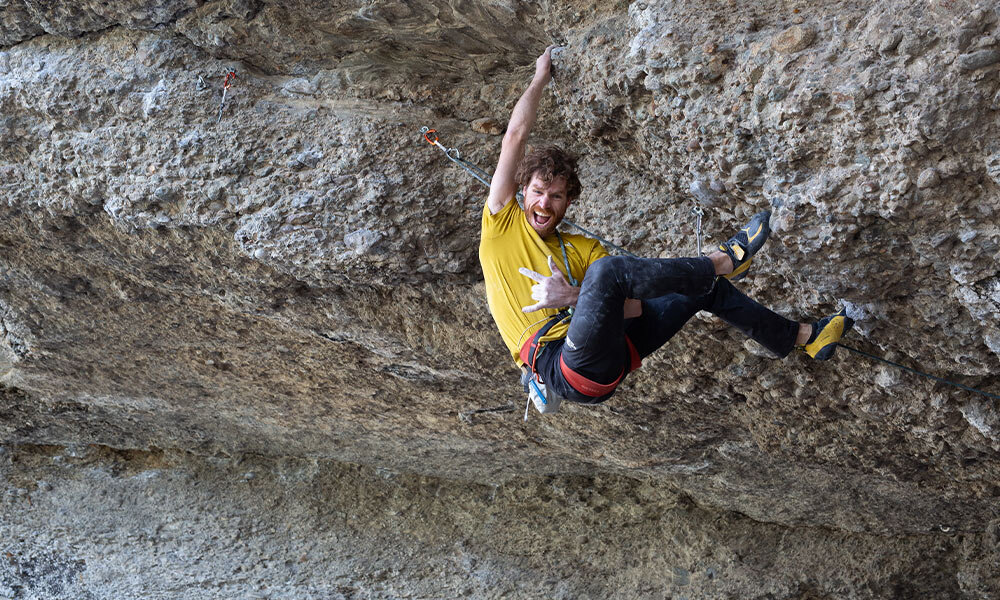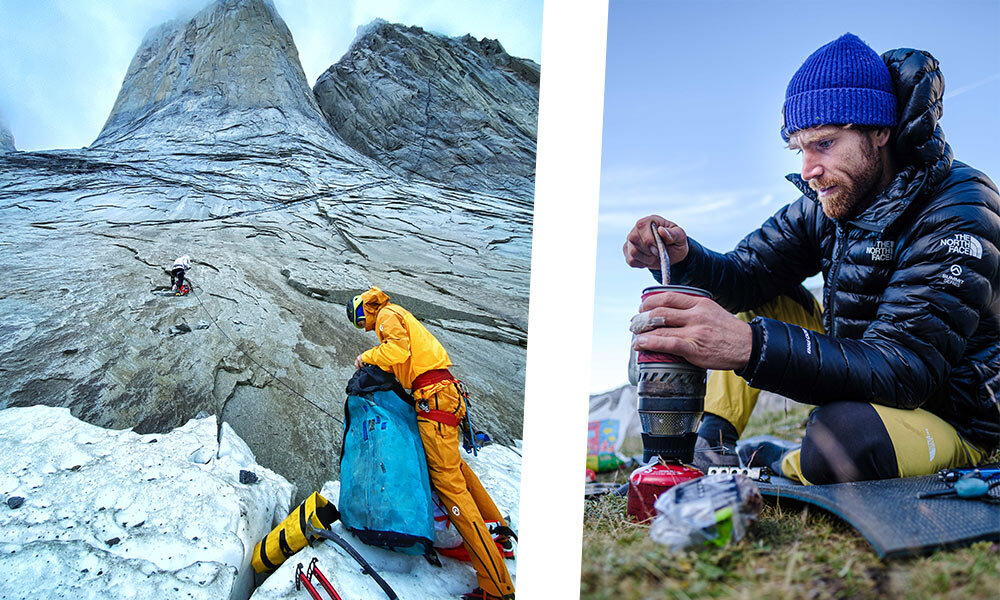- “South face” / Mount Watkins (Yosemite) / 19 pitches / 5.13b (8a) – freeclimbed in 12 hours / 11/2017
- “Freerider” / El Capitan (Yosemite) / 36 pitches / 5.13a (7c+) – freeclimbed in 15hours / Onsight except for the boulder problem pitch / 11/2017
- “El Corazon” / El Capitan (Yosemite) / 35 pitches / 5.13b (8a) – freeclimbed capsule style in three days / 11/2017
- “Greenspit” 8b/+, Valle del Orco, Italy, 08/2012
-
· “El Regalo de Mwono” / Torre Central East Face Torres de Paine (Chile) / 26 pitches Free grade: 8a / original grade: VI 5.11 A4 / First team free ascent / 02/2017
- „Fire in The Belly” / FA and FFA / Tsaranoro Atsimo (Madagascar) / 12 pitches – 700 m / 8a++ / 08/2015
- “Kids With Guns” / Amuri Tepuy (Venezuela) / 21 pitches – 450m / 5.13a A3 (E6 6c) / Big wall expedition, fixing ropes and capsule style, 12 days on the wall. Most of the pitches have been done free. / 02/2012
Career Highlights
- “Project Fear” / Tre Cime (Dolomites) / 8b+/c multipitch / First free ascent link up / 08/2021
- “Histoire sans Fin” / Petit Clocher du Portalet (Swiss) / 8b+ multipitch / 2th free ascent / 08/2021
- “Fly” / Lauterbrunnen (Swiss) / 8c multipitch / 2th/3th free ascent / 06/2021
- “Parthian Shot” / E9 6c / Peak District / 10/2021
- 9a sport climb “Estado Critico” Siurana (Spain) / 04/2021
- “Orbayu” / Picu Ureillu (Spain) / 5th free ascent / 8c sport/trad multipitch / 08/2020
- “Silbergeier” / Rätikon (Swiss) / 6 pitches / Free Ascent in one day without any falls / 8b+ / 08/2019
- “Yeah Man” / Gastlosen (Swiss) / 9 pitches / Third Free Ascent / 8b+ / 08/2019
- “Sense Retorn” / Mont-Rebei (Spain) / 9 pitches / First (ground up) Ascent and First Free Ascent / 7c+ / 04/2019

Favorite places to live / climb / visit
Live => Any place that has a warming and friendly (climbing) community. Preferable in a village in some remote place. With a culture of getting together for drinking coffees, having dinners and beers.
Climb => Yosemite, Freyr (Belgium), Indian Creek, Patagonia,…
Visit => Any climbing area! But I love the small mountain villages with a local square. If it is Spain, France or Italy,… it all doesn’t matter.
Favorite type of climbing (bouldering, sports climbing, trad, etc.):
Trad climbing and Big Wall climbing
Interview
-
Climbing
When and how did you get into climbing and what kept you interested / fascinated in the sport?
I got into climbing when my parents send me on an indoor summer camp to the local climbing gym. I was 9 years old when I first climbed on plastic. Since that summer, every school holiday I wanted to take part of this indoor camp, regardless the fact that all the activities where exactly the same. At an age of 10 I got into the local climbing team, climbing twice a week. Soon this turned in to 5 times per week, the climbing gym became my second home. The people and community encouraged and supported me so much I just felt safe to be who I was, with all my eagerness to climb hard and push myself.
I experienced two main drivers that kept me interested in the sport; the climbing itself and the lifestyle and community. Climbing hard, training and pushing my own limits physically as well as mentally on one side. On the other hand; traveling low key, finding your path as a dirtbag in an unknown culture, getting to learn new languages, sharing stories and getting into discussions about the values in climbing and life. In the end it’s been about self-development and interaction with my environment.
After some adolescent years of sport- and competition climbing my focus turned towards adventure. All I wanted was trad and crackclimbing in the best places on earth. I went from one expedition to the other and was never home, the search for the unknown kept me going. Since 2019 something changed, I had a great desire to become ‘stronger’. Instead of searching for the adventure in climbing I wanted to spend more time to discover my athletic limits. All with the dream to climb the most difficult big walls in the world, because adventure has always been a driver. I rediscovered climbing ‘hard’ and the challenges of pushing my own athletic skills. Yet one more time the sport opened up for me and I got to know many new challenges in becoming a ‘better’ climber.
Who was your childhood hero and do you consider yourself a role model now? Does it influence you at all that other people look up to you?
I did not have any specific childhood hero. I did look up to local climbers’ behavior and the importance they gave to ‘style’ and ethics, the way you had tried and climbed a route was important. I do see myself as a role model today, it is inevitable as a professional climber. It for sure influences the way I communicate about my climbing. I am conscious about the impact I have and try to use that impact to do good for others, our community and our playground. It can be in the form of inspiring them or even by giving people feedback on their climbing behavior based on what I see.
What were the most important milestones in your life so far, both in climbing and in everyday life? Did you immediately recognize them as such or only later on?
Recognizing the importance of these milestones only months or years later, I would say the next two stand out.
The first one coming to mind is a trip of several months to the USA at an age of 19. Together with my newly bought Chevy G20 Van I took off searching for adventure, climbing and climbing partners. This trip gave me a boost, my self esteem and feeling of self worthy rose. The world opened up with many possible paths.
A second very important milestone came after a light ‘depression’ in 2018. I had made many decisions in life based on what I thought that was expected from me. I lived with intense mood swings, ups and downs, and jumped from one project to the other. Since that summer I decided to focus on what I really wanted. First of all, become a stronger climber being able to focus on long term goals. I also realized I wanted to explore more of my capabilities outside of climbing. Which since 2020 resulted in becoming a leadership and development coach working with teams in the corporate world. My main goal is to help people feel good with what they do and who they are in life. Support them in becoming more effective and happy people.
What were your greatest failures / setbacks / injuries? How did you cope with them and how did you come back from them?
It’s hard to think about one great failure from the past. At the moment of the ‘failure’ it feels like a failure. But when time goes on I always manage to twist my mindset about this event and see it as a learning opportunity I had needed to grow as a climber or human. From not sending what would be my second 8b+ at an age of 15, to an expedition without first ascent or first free ascent, to not sending the Dawn Wall in my first season. All these events I do not see as failures anymore.
Injuries I luckily never had (I’m knocking on wood right now). A big setback I did have, the ‘light’ depression I talked about above. The reason for this was continuous self doubt and doubt about my skills as a professional climber. Also questioning continually if I ‘deserve’ this lifestyle. I lost the sense of climbing for a moment; “Why did I like climbing?” “For who am I doing this?” ”Am I still intrinsically motivated?”. I reconnected with myself during one summer without any climbing and found my intrinsic motivation back. Sometimes you go deep to peak high again.
What is your favorite climbing related story / experience?
The story about the route I climbed in Siurana, Spain. “Pati Noso” 8c/c+.
The first morning after my very first night in a portaledge! Waking up in the middle of a 500meter overhanging bigwall in the jungle of Venezuela. Being a total dummy, I had to find out how to live on the wall. Starting with the most basic human needs, like having a leak. Clumsy, insecure and excited I peed over the edge of the portaledge when only 1 second after I had done my thing, the portaledge slid away below me. I flipped over, ending up dangling on one arm on the side of a vertical hanging portaledge looking into the eyes of my climbing partners and cracking up all together!
-
Training
Do you have a strict training schedule for when and how you train throughout the year?
I do have a training schedule throughout the year that’s fairly adaptable to my traveling lifestyle. I try to keep it strict but it’s not always easy when moving around the world a lot. This is why it’s super important for me to at least spent 3 months per year in the same spot where I can focus on training and getting stronger.
What advice can you give to somebody looking to improve their training routine?
Make sure you create habits in your week or climbing day. Do your core training always at the same moment of the week; do your flexibility training always in the morning, at night, or while having a chat with friends in the living room; do a set of antagonist exercises just before or after an indoor session; etc… Make sure you create good habits.
Second, make it yourself easy. Do you have some exercises with weight and you always have to go to a gym for them? Maybe it’s worth buying some and having them at home or in the Van. Make sure you do not have an excuse to not train!
What do you think of indoor climbing gyms in relation to climbing on actual rock?
They are a perfect tool to get stronger. You can train very specific and goal oriented. I love to just brainlessly train and give my best in every move or repetition.
Are you able to do a one-arm pull-up? How about a single finger?
A one-arm pull-up? Only when I’m on my very best! Let’s not talk about single fingers… I climb with my feet ;)
How much of the success as a pro climber is due to show and how much due to actual climbing skill?
We all know that as a pro climber we can become very famous if your branding and marketing is on a good level. If you know how to work with Instagram and its most recent developments you can reach a lot of people and be somehow ‘successful’. But if you want to be durable as a proclimber, you need to perform and be a strong climber. You cannot just surf on the waves of Instagram forever. I believe not only physical strength but also vision and positive energy can define your success. To create real credibility, climbing skills and authenticity are key. To have impact on the climbing ethics and culture, credibility is key.
-
Psychology
Is it possible for anybody to eventually perform a one-armed pull-up or get to the top of the Eiger/Matterhorn, or do you really have to be born for it?
Maybe you would need a minimum of physical health and condition. In generally I would state that for both these objectives you can train and prepare yourself as long as you are willing to put enough time and effort in. Discipline and ability to listen to your body are crucial capabilities. To show discipline, you need one key ingredient: motivation!
How important is it to set goals in professional sports? What are your goals / targets you are working towards in climbing and in life?
For me goals have been super important in my life. I’m a very goal oriented person. Maybe I’m a bit addicted to goals as well , I always need a goal, it brings me mental rest to know I’m aiming for something. I am conscious it’s not always good and being able to just ‘be’, is an incredible quality I might still have to develop.
My goals? Pushing my climbing skills as a big wall climber. Climbing harder and more difficult big walls in a good style. Ground-up, doing pushes, onsights, one-day ascents, first free ascents in altitude,… The Dawn Wall is still a big goal on my list, probably even the biggest one for now. This is the more physical kind of goal. A very personal goal of mine is to be more kind with myself, more patient and more supporting. I will always put a lot of pressure on myself, which I believe is my strength. A strength that turns into a weakness when it’s overcultivated. And last, connected to being goal-oriented I would love to be able to be more process oriented and give less importance to the actual result. But that’s the beauty of climbing and all its challenges, it pushes you to keep developing yourself.
How to you deal with extremely hard climbing problems? Do you ever get frustrated and give up on them or do they motivate you even more?
Love these questions! I am definitely someone who gets frustrated. I already mentioned I do not have so much patience and I put the bar very high for myself. If I’m encountered with a hard boulderproblem, I get this boost of energy to find a solution. Back in the day it was just all about trying hard, more, quick and then even harder! Right now, I try to give myself and my body more time to learn and get to know the holds, the feet and eventually the moves. And if it doesn’t work, I still might be upset but that feeling transforms quick into motivation to become better.
-
Future of climbing
Is there anything you would like to change about the current developments in climbing?
“Communication”. I am impressed by how climbers are getting very creative to reach specific goals and use all the possible tools to climb the boulders, trad climbs, sportclimbs and big walls they aim for. I am learning so much from the younger generations. But for me style and the process on how they climbed their route is important. The style you climb a route is what makes it often more impressive. I’m not talking about what kind of nice and colorful lycra pants he or she was wearing. I talk about ground-up, link-up, one day, a push, rapping in or not, using hand placed gear, … It’s important to keep communicating about how you climbed a route and I wish for the climbing community to stay transparent and sincere to each other.
Where do you think sport will go in the next few years? What will change? And what role will you play in it?
We all see a growing climbing community, mainly in the gym. As a results climbing is seen and approached as a sport and a tool to reach physical goals. But climbing in its roots is not just a sport, it is a lifestyle and a culture with strong values. I see it as my role to really transmit these values, pass them on and teach new climbers about them. A value that got more and more important is the value to take care of our climbing areas and nature as our community is growing. Respect for nature but also local communities became more important. The social aspect of climbing as a lifestyle has always been really important to me. It’s important to connect with locals, inform yourself about do’s and don’ts in the area and act accordingly. I always loved the local history and habits, it’s been so enriching for me as a person and climber. I wish all climbers the same and see it as my duty to help protect local climbing habits and culture.
Then there is climate change. Climbers have a big impact on climate change. I’m still struggling as a professional athlete on how to deal and communicate about this. Taking a plane, big travels and consummation of food and gear, it all has impact and I’m aware. I am happy to walk the path to a new way of climbing and traveling with my fellow climbers. Starting with being aware and giving up some excessive luxury.







